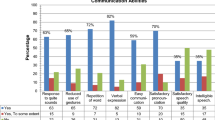Abstract
Purpose
The role of cochlear implant in deaf children development is well-known. However, the results are highly variable and depend on several factors. The most important role belongs to the family, family environment in which the child develops. The aim of the study was to evaluate the features of the family environment in which cochlear-implanted children develop.
Methods
The questionnaire “Family Environment Scale” was sent to 108 families who had cochlear-implanted child with more than 6 months of experience. One of the parents was asked to fill out the questionnaire which also included general information about the child and the family.
Results
A total of 58 families responded to the questionnaire and accepted to participate in the study. Mean values were higher compared with normal families in the areas of cohesion, expressiveness, intellectual-cultural orientation and organization, but the cohesion and organization score mean value exceeded the normal values (between 40 and 60). The independence and the conflict areas had lower values than normal families but did not exceed the lower limit of normal (40).
Conclusions
The relationship between the family and the auditory-verbal development potential of the cochlear-implanted child is obvious. However, further studies are needed to establish correlations between the characteristics of the family environment and the level of auditory-verbal and psycho-cognitive development of the cochlear-implanted child so we can act on the family environment through education or therapy, to get maximum benefit with these children.


Similar content being viewed by others
References
Marschark M (1997) Raising and educating a deaf child. Oxford UniversityPress, New York
Calderon R, Naidu S (2000) Further support of the benefits of early identification and intervention with children with hearing loss. Volta Rev 100(5):53–84
Yoshinaga-Itano C, Sedey AL, Coulter DK, Mehl AL (1998) The language of earlyand later-identified children with hearing loss. Pediatrics 102:1161–1171
Seligman M, Darling RB (2007) Ordinary families, special children: a systems approach to childhood disability, 3rd edn. Guilford Press, New York
Lynch RT, Morley KL (1995) Adaptation to pediatric physical disability within the family system: a conceptual model for counseling families. Fam J 3(3):207–217. https://doi.org/10.1177/1066480714547189
Oelofsen N, Richardson P (2006) Sense of coherence and parenting stress in mothers and fathers of preschool children with developmental disability. J Intellect Dev Disabil 31(1):1–12. https://doi.org/10.1080/13668250500349367
Repetti RL, Taylor SE, Seeman TE (2002) Risky families. Psychol Bull 128:330–366
Dowell RC, Dettman SJ, Blamey PJ, Barker EJ, Clark GM (2002) Speech perception in children using cochlear implants: prediction of long-term outcomes. Cochlear Implants Int 3:1–18. https://doi.org/10.1002/cii.48
Gupta D (2012) A predictive model for outcome of cochlear implantation in children below the age of 5 years: a multivariate analysis in Indian scenario. Indian J Otol 18:129–135
Geers A, Nicholas JG, Sedey AI (2003) Language skills of children with early cochlear implantation. Ear Hear 24(1 Suppl):46S–58S
Moeller MP (2000) Intervention and language development in children who are deaf and hard of hearing. Pediatrics 106:E43
Luterman D (2006) Children with hearing loss—a family guide. Aurikle Ink, Sedona
Feher-Prout T (1996) Stress and coping in families with deaf children. J Deaf Stud Deaf Educ 1(3):155–165
Darling N, Steiberg L (1993) Parenting style as a context: an integrative model. Psychol Bull 113:487–496
Vachha B, Adams R (2009) Implications of family environment and language development: comparing typically developing children to those with spina bifida. J Compil (Blackwell Publishing Ltd, Child: care, health and development) 35(5):709–716
Moos R, Moos B (2009) Family environment scale manual and sampler set: development, applications and research, 4th edn. Mind Garden Inc., Palo Alto
Gilmour L (2010) The inter-rater reliability of categories of auditory performance-II (CAP)-II. Masters thesis, Institute of Sound and Vibration Research, University of Southampton
Lejeune B, Demanez L (2006) Speech discrimination and intelligibility: outcome of deaf children fitted with hearing aids or cochlear implants. B-ENT 2:63–68
Holt RF, Beer J, Kronenberger WG, Pisoni DB (2013) Developmental effects of family environment on outcomes in pediatric cochlear implant recipients. Otol Neurotol 34(3):388–395
Vermaes IPR, Gerris JRM, Janssens JMAM (2005) The quality of primary relationships in families of children with spina bifida. Cerebrospinal Fluid Res 2(Suppl 1):S43
Belardinelli C, Hatch JP, Olvera RL, Fonseca M, Caetano SC, Nicoletti M, Soares JC (2008) Family environment patterns in families with bipolar children. J Affect Disord 107(1–3):299–305. https://doi.org/10.1016/j.jad.2007.08
Author information
Authors and Affiliations
Corresponding author
Ethics declarations
Conflict of interest
The authors declare that they have no conflict of interest.
Ethical statement
All procedures performed in studies involving human participants were in accordance with the ethical standards of the institutional and/or national research committee and with the 1964 Helsinki declaration and its later amendments or comparable ethical standards.
Rights and permissions
About this article
Cite this article
Necula, V., Cosgarea, M. & Maniu, A.A. Effects of family environment features on cochlear-implanted children. Eur Arch Otorhinolaryngol 275, 2209–2217 (2018). https://doi.org/10.1007/s00405-018-5056-7
Received:
Accepted:
Published:
Issue Date:
DOI: https://doi.org/10.1007/s00405-018-5056-7




